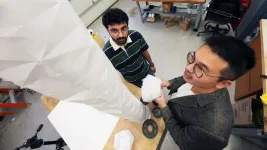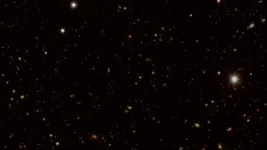(Press-News.org) How do you deploy an environmental sensor to collect climate change readings over a prolonged period on an uninhabited island without failing? How do you power a seismic detector to operate for months in an underwater cave?
In environments that are difficult to reach because of the hazards or hardships for humans, a device behaving like a native plant could be the answer. This is the approach taken by Suyi Li, associate professor in mechanical engineering at Virginia Tech, and Clemson professor and collaborator Ian Walker. Their work is being advanced thanks to a four-year, $840,000 grant from the National Science Foundation.
“When I started to venture into robotics a few years ago, I was surprised to see that almost all robots are inspired by humans and animals to some degree,” Li said. “However, I believe the vast plant kingdom can offer us many unique lessons on approaching the design, actuation, and operation of robots. This is how Ian and I started working on this topic together. “
Li has established a research group that deploys the principles of origami to create novel forms of soft robotics with unique structures. Walker, a professor of electrical and computer engineering at Clemson, brings a rich background in biologically inspired robotics spanning two decades. Their proposal aims to create a broad foundation for new designs, creating robotics with technology capable of surviving in wild conditions over the long haul.
Robots in the wild
Bringing together cutting-edge electronics with the unpredictability of nature is typically a clash of worlds. Technology can be a strength when electricity is available, and the environment is predictable or controlled. Those measures break down when batteries die and parts break.
This has not prevented technology from making its way into the outdoors, but challenges have followed. Other researchers recently deployed sensors for wildfire detection in remote locations of California and Oregon, but have faced issues such as navigating rocky areas at high altitudes and the particulars of protected lands.
Devices that need to be always on and programmed to detect such things as airborne particles or rare breeds of birds generally face two big obstacles: time and environment. These are the main challenges Li’s team is tackling. The aim isn’t to fight against the flow of nature, but to channel the very approach used by nature to produce more adaptive robotics.
“As humans, we naturally tend to think of change on the time scale of our attention span, like seconds and minutes,” Walker said. “However, long-term and continuous deployments outdoors pose alternative and unique challenges. Over weeks and months, outdoor natural environments are highly dynamic places. Vegetation grows up and debris comes down in storms. Robotic operation in these conditions needs to become more like the ambient environment in novel ways to maintain monitoring.”
Robots that grow and adapt
Li and Walker will not be creating robot plants or making sensors that grow from seeds. Instead, their work will take advantage of the insights provided by nature that have proven to be durable over the long term. Those natural mechanisms will be converted into mechanics that adapt and respond to their environments.
Which characteristics of plants are on their radar? They have targeted the ability to move with the sun, shown in the behavior of sunflowers. Also of interest are floral organs that open and close, like a venus flytrap. They also have taken notes from plants that attach to an object adaptively, like the winding of vines around a tree. All of these actions are the result of a plant adapting to its surroundings, and each has a set of mechanisms that make the action possible. Some of the actions are faster, like the flytrap. Some are slower, like the steady coil of vines.
To put these characteristics together into robotics, Li and Walker have combined their efforts to mimic those plant behaviors and package them as a set of innovative robotics.
Li’s team will use its expertise in engineering through origami to create accordion-like robotic trunks that can unfold and self-lock, pairing it with Walker’s knowledge of bio-inspired electronics to create a container that is durable and capable of responding to the dynamics of an outdoor environment. This trunk would have the ability to adapt within congested spaces that may form as foliage grows and becomes thick. Adapting in this way has the potential to overcome obstacles that might normally shut down a robot’s operation.
To sense the movement of the environment, Li and Walker foresee using the model of tree leaves and needles to guide their design. These extensions will be outfitted with devices that guide the operation and “growing” action, feeding information about real-time changes into the electronics contained in the trunk to tell the robot how to adapt. These might include elements such as light sensors, taking a cue from sunflowers. Bio-inspired needles could also interact with their environment to push aside foliage that interferes with environmental monitoring.
“Nature provides a huge variety of existence proofs for how robotics structures might be designed and operate,” Walker said. “In particular, characteristics of plant behavior give insight into how systems can successfully adapt and thrive in the natural environment.”
Supplying power to electronics is critical as robots can't function on dead batteries, but maintaining an electric source is difficult in places that are hard for humans to reach. Because of that necessity, energy harvesting that mimics real plants can keep powering a robot and prevent it from missing crucial data where changing batteries isn’t an option. Li and Walker's team is doing preliminary work into the methods needed to power their robotics, building on its early work that also includes energy efficiency. By using novel harvesting approaches with a light diet of energy consumption, researchers can tackle the challenge of keeping a robot running over long periods of time, which is important when deploying sensors in areas that are unpredictable, inhospitable, or remote.
The approach for each plant-inspired robot also will be tuned to the length of time over which it will operate. Li and Walker’s approach for a robot that measures long-term pollution levels over months or years, for instance, will be different than that of a robot tasked with rare animal sightings over days or weeks.
Eventually, the group hopes to build a new breed of robots that can adapt to and protect our environment over months and years, monitoring slow-changing processes like temperature and humidity as well as rapidly occurring events like wildfire outbreaks.
“When monitoring city environments, having static devices is not a problem because the environment is controlled,” Li said. “But in areas like coral reefs or forests with dynamic and volatile surroundings, having a robotic plant that can grow and adapt with its environment instead of needing to be replaced and moved by humans will revolutionize how we are able to study and monitor remote regions.”
END
Origami-inspired robotic plants grow with their environment
Researchers at Virginia Tech and Clemson collaborate to produce robotic sensors that mimic the characteristics of plants for optimal environmental monitoring
2024-01-08
ELSE PRESS RELEASES FROM THIS DATE:
New research identifies high rates and common causes of diagnostic errors in hospitals across the nation
2024-01-08
Almost a quarter of patients who were admitted to the ICU or died in 29 hospitals in the United States experienced a diagnostic error
Efforts and initiatives are underway across the country to address and prevent the causes of diagnostic errors
A new study from researchers from Brigham and Women’s Hospital, a founding member of the Mass General Brigham healthcare system, in collaboration with researchers at the University of California San Francisco, has shed light on the rate and impact of diagnostic errors in hospital settings. In an analysis of electronic health records from 29 hospitals across the country of 2,428 patients who ...
Final supernova results from Dark Energy Survey offer unique insights into the expansion of the universe
2024-01-08
In 1998, astrophysicists discovered that the universe is expanding at an accelerating rate, attributed to a mysterious entity called dark energy that makes up about 70% of our universe. While foreshadowed by earlier measurements, the discovery was somewhat of a surprise; at the time, astrophysicists agreed that the universe’s expansion should be slowing down because of gravity.
This revolutionary discovery, which astrophysicists achieved with observations of specific kinds of exploding stars, called type Ia (read “type one-A”) ...
Life span increases in mice when specific brain cells are activated
2024-01-08
In recent years, research has begun to reveal that the lines of communication between the body’s organs are key regulators of aging. When these lines are open, the body’s organs and systems work well together. But with age, communication lines deteriorate, and organs don’t get the molecular and electrical messages they need to function properly.
A new study from Washington University School of Medicine in St. Louis identifies, in mice, a critical communication pathway connecting the brain and the body’s fat tissue in a feedback loop ...
Robotic rehab aims to help stroke patients regain hand dexterity
2024-01-08
Every year, about 800,000 new stroke cases are reported in the United States, often causing patients problems with both neurological and physical motor control. Disruptions in the mobility of the arms and hands, in particular, can have devastating impacts on stroke patients’ quality of life.
The restoration of arm extremity and hand dexterity are often the highest priority among stroke patients. A new robotic platform developed at the University of Rhode Island, which utilizes both a patient’s brainwaves and muscle activity, aims to help post-stroke patients perform needed rehabilitation and regain critical motor skills, including complex tasks like reaching and grasping ...
Illinois Tech launches sensor technology program with emphasis on veteran education
2024-01-08
CHICAGO—January 8, 2023—Illinois Institute of Technology (Illinois Tech) has received a substantial grant from the National Science Foundation (NSF) to launch a pioneering education program in sensory technology aimed at underrepresented groups—particularly veterans. The initiative, funded through NSF’s Experiential Learning for Emerging and Novel Technologies (ExLENT) program, underscores Illinois Tech’s commitment to critical future technologies and expanding education to groups that have historically ...
Study highlights barriers to contraceptive access for disabled Medicare enrollees
2024-01-08
PITTSBURGH — Contraceptive use is low among reproductive-aged people with disabilities who are enrolled in Medicare, according to a new study from the University of Pittsburgh that highlights how lack of contraceptive coverage by Medicare may prevent disabled enrollees from accessing contraception.
Published today in the January issue of Health Affairs, the study provides the first national overview of contraceptive use among enrollees in Medicare, the government health insurance for people over 65 and for people with qualifying disabilities. ...
Study of national data demonstrates the value of acute hospital care at home
2024-01-08
Since the Centers for Medicare and Medicaid Services launched the Acute Hospital Care at Home (AHCaH) Waiver in 2020, thousands of patients from across 300 hospitals in 37 states have been treated in their homes. Yet little is understood about these patients’ outcomes on a national level, and the waiver will end in December 2024 unless there is an act from Congress. A new study by investigators from Mass General Brigham analyzed outcomes from AHCaH for a diverse group of patients across America. The study provides preliminary evidence suggesting that home hospital ...
Hospital care at home benefits medically complex, socially vulnerable patients
2024-01-08
Embargoed for release until 5:00 p.m. ET on Monday 8 January 2024
Annals of Internal Medicine Tip Sheet
@Annalsofim
Below please find summaries of new articles that will be published in the next issue of Annals of Internal Medicine. The summaries are not intended to substitute for the full articles as a source of information. This information is under strict embargo and by taking it into possession, media representatives are committing to the terms of the embargo not only on their ...
Real-world analysis: COVID-19 vaccine strongly effective for children and adolescents during delta and omicron
2024-01-08
Children and adolescents who received one of the main COVID-19 vaccines were significantly protected from the illness and showed no increased signs of cardiac complications compared to young people who were not vaccinated, according to a new real-world study led by researchers from the Perelman School of Medicine at the University of Pennsylvania and Children’s Hospital of Philadelphia (CHOP). When the Delta variant rose to prominence, the study showed that vaccinated young people were 98 percent less likely to be infected than their unvaccinated peers, and ...
Studying cells to improve medulloblastoma treatment
2024-01-08
Research is shedding light and potentially expanding options for patients living with Medulloblastoma, an aggressive childhood cancer.
Medulloblastoma is a cancer impacting both very young and school aged children.
When children get this type of brain tumor, they experience the process of the tumor blocking flow of fluid around the brain.
This can cause severe headaches, vomiting, sleepiness, fussiness, and difficulty walking and coordinating movements.
Treatment is intense, involving high dose chemotherapy, surgery, and sometimes radiation or stem cell transplants.
During these months long treatments, children may lose ...
LAST 30 PRESS RELEASES:
For teens, any cannabis use may have impact on emotional health, academic performance
School meals could unlock major gains for human and planetary health
Menopause hormone therapy does not appear to impact dementia risk
Signature patterns of brain activity may help predict recovery from traumatic brain injury
Dresden study uncovers new key mechanism in cancer cells
New species are now being discovered faster than ever before, study suggests
Cannabis-based products show limited short-term benefit for chronic pain, with increased risk of adverse effects
Cannabis products with more THC slightly reduce pain but cause more side effects
Clearing the brain of aging cells could aid epilepsy and reduce seizures
Brain injuries linked with potential risk of suicide, new study finds
New technique lights up where drugs go in the body, cell by cell
New study finds movement of fishing fleets can reveal shifts in marine ecosystems
Embargoed: New evidence points to potential treatment for vascular dementia
Study uncovers disrupted brain balance in alcohol dependence
Working in groups can help Republicans and Democrats agree on controversial content moderation online
Structural findings reveal how distinct GPCR ligands create different levels of activation
Anything-goes “anyons” may be at the root of surprising quantum experiments
UC review: Maximizing workplace opportunity for veterans
From generation to complex control: Metasurfaces make perfect vortex beams "within reach"
Thin-film lithium niobate-based detector: recent advances and perspectives
Exploring why some people may tend to persistently make bad choices
How cells balance their protein levels
Nirsevimab vs RSVpreF vaccine for RSV–related hospitalization in newborns
Effectiveness and impact of maternal RSV immunization and nirsevimab on medically attended RSV in US children
AI gives scientists a boost, but at the cost of too many mediocre papers
Next-generation vision model maps tree growth at sub-meter precision
Genes aren’t destiny for inherited blindness, study shows
MIT study: High-fat diets make liver cells more likely to become cancerous
Exposure to multiple fine particulate matter components and incident depression in the US Medicare population
Risk of burdensome health care spending over time in the US
[Press-News.org] Origami-inspired robotic plants grow with their environmentResearchers at Virginia Tech and Clemson collaborate to produce robotic sensors that mimic the characteristics of plants for optimal environmental monitoring



